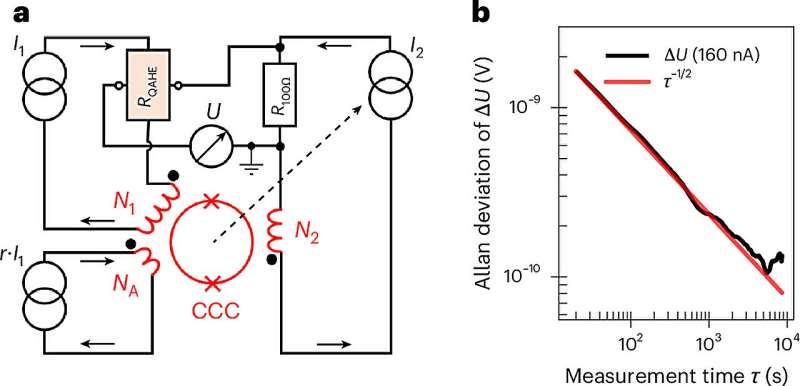
December 4, 2024 by University of Würzburg
Collected at: https://phys.org/news/2024-12-quantum-resistance-standard-external-magnetic.html
Scientists at the University of Würzburg and the German national metrology institute (PTB) have carried out an experiment that realizes a new kind of quantum standard of resistance. It’s based on the Quantum Anomalous Hall Effect.
The work has been published in Nature.
The precise measurement of electrical resistance is essential in industrial production or electronics—for example, in the manufacture of high-tech sensors, microchips and flight controls.
“Very precise measurements are essential here, as even the smallest deviations can significantly affect these complex systems,” explains Professor Charles Gould, a physicist at the Institute for Topological Insulators at the University of Würzburg (JMU).
The scientists now, for the first time, have experimentally implemented a so-called quantum resistance standard that can operate without an externally applied magnetic field.
“In physics, standards are used as fixed reference points for the precise measurement of physical quantities and the calibration of measuring instruments,” says Gould. “A quantum standard operates based on invariant principles of quantum mechanics, which makes it extraordinarily stable.”
How the standard works
Many people may remember the classic Hall effect from their physics lessons: when a current flows through a conductor and it is exposed to a magnetic field, a voltage is created—the so-called Hall voltage. Dividing this voltage by the current produces the Hall resistance.
It increases as the magnetic field is strengthened. In extremely thin conductors below a few nanometers (for comparison: a human hair is about 100,000 nanometers thick) and with very strong magnetic fields, the resistance no longer increases continuously, but always reaches the same fixed values (discrete steps that have universal values, and are independent of any device properties).
This is known as the Quantum Hall Effect (QHE). The fact that the resistance in the QHE takes on universal values makes it the ideal basis for determining the resistance standard.
The special feature of the Quantum Anomalous Hall Effect (QAHE) is that it allows the quantum Hall effect to exist at zero magnetic field.
“The operation in the absence of any external magnetic field not only simplifies the experiment, but also gives an advantage when it comes to determining another physical quantity: the kilogram. To define a kilogram, one has to measure the electrical resistance and the voltage standards at the same time,” says Gould, “but measuring the voltage standard only works without a magnetic field, so the QAHE is ideal for this.”
Until now, the measurements of the QAHE at zero external magnetic field lacked the precision required by modern applications in quantum metrology. The new measurements for the first time places the magnetic field-free QAHE standard on par with early conventional QHE-based resistance standards, reaching the necessary precision thresholds.
Further plans
So far, the operation of the quantum resistance standard without an external magnetic field remains limited to extremely low temperatures and low currents. In order to make the standard commercially usable in the future, for example for industry, the experiment needs to be further improved.
Therefore, Gould’s Würzburg team continues to work towards that end with the Physikalisch-Technische Bundesanstalt (PTB) in Braunschweig, Germany, and with international researchers as part of the European metrology consortium QuAHMET.
More information: D. K. Patel, et al. A zero magnetic field quantum standard of resistance at the 10-9 level, Nature (2024). DOI: 10.1038/s41928-024-01295-w
Journal information: Nature

Leave a Reply